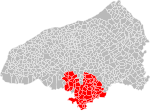Parlement of Rouen
History of NormandyParlements

The Parlement of Rouen (French: Parlement de Rouen), also known as the Parlement of Normandy (French: Parlement de Normandie) after the place where it sat (the provincial capital of Normandy), was a provincial parlement of the Kingdom of France. It replaced the ancient court of the exchequer of Normandy, set up by Rollo, first duke of Normandy. The parlement was built in a mixing of the French Flamboyant style and Renaissance architecture by Roger Ango and Roulland le Roux, between 1499 and 1508, during the reign of the king Louis XII of France. Today, the building is the seat of the courthouse of the city of Rouen.
Excerpt from the Wikipedia article Parlement of Rouen (License: CC BY-SA 3.0, Authors, Images).Parlement of Rouen
Rue Saint-Lô, Rouen Quartier Vieux-Marché Cathédrale
Geographical coordinates (GPS) Address Phone number Website Nearby Places Show on map
Geographical coordinates (GPS)
| Latitude | Longitude |
|---|---|
| N 49.4423 ° | E 1.0926 ° |
Address
Utile
Rue Saint-Lô 29
76000 Rouen, Quartier Vieux-Marché Cathédrale
Normandy, France
Open on Google Maps









